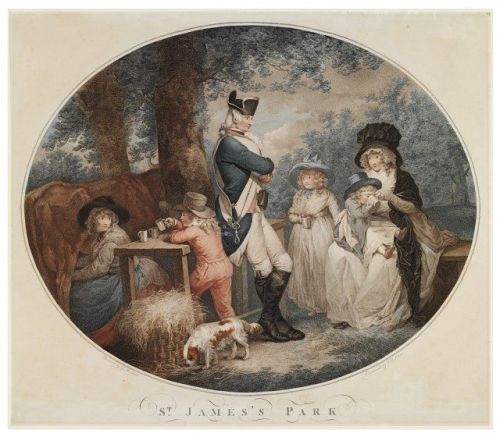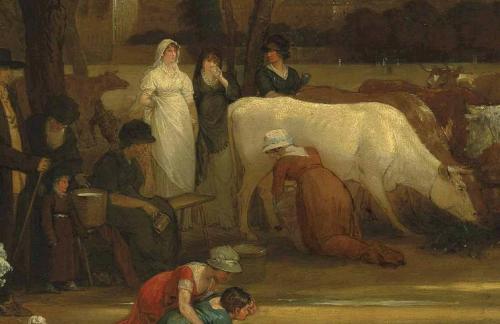St. James’s Park offered some of the freshest, most wholesome milk during a Georgian London summer – the frothy hot liquid, or new milk, was drawn at the request of customers from cows that had grazed on the park’s lawns.
An estimated 8,500 cows were kept for milk near London.* Farmers milked their herds and carted in the milk to dairy retailers from as much as 20 miles away.

St James’s Park, Soiron, François David, about 1780, Colour stipple engraving, with additional colour by hand. Bequeathed by Mrs M. V. Cunliffe. V & A Museum
In idealized scenes, artists give us an insight into contemporary customs. A milkmaid is milking a cow in St. James’s Park as a young boy in a skeleton suit waits with his empty cup. The party consists of a soldier and a mother with two other children, a boy and a girl. These two have already received their share of milk, with the mother helping the younger child sitting on her lap. It is hard to tell if it is a girl or a boy, for in their early years both sexes were dressed similarly.
One is struck by the tin cups on display at the wood table. There are no washing facilities nearby, and one can only assume that these cups are reused by strangers. A more finicky person would probably bring their own cup to the park. In this instance, a basket filled with hay is placed next to the table, ostensibly as fodder for the cow.
The following illuminating passage c0mes from Henry Mayhew’s account of London Labour and the London Poor, 1861 (Tufts Digital Library:
The principal sale of milk from the cow is in St. James’s Park. The once fashionable drink known as syllabubs—the milk being drawn warm from the cow’s udder, upon a portion of wine, sugar, spice, &c.—is now unknown. As the sellers of milk in the park are merely the servants of cow-keepers, and attend to the sale as a part of their business, no lengthened notice is required.
The milk-sellers obtain leave from the Home Secretary, to ply their trade in the park. There are stands in the summer, and as many cows, but in the winter there are only cows. The milk-vendors sell upon an average, in the summer, from eighteen to quarts per day; in the winter, not more than a of that quantity. The interrupted milking of the cows, as practised in the Park, often causes them to give less milk, than they would in the ordinary way. The chief customers are infants, and adults, and others, of a delicate constitution, who have been recommended to take new milk. On a wet day scarcely any milk can be disposed of. Soldiers are occasional customers.
A somewhat sour-tempered old woman, speaking as if she had been crossed in love, but experienced in this trade, gave me the following account:
It’s not at all a lively sort of life, selling milk from the cows, though some thinks it’s a gay time in the Park! I’ve often been dull enough, and could see nothing to interest one, sitting alongside a cow. People drink new milk for their health, and I’ve served a good many such. They’re mostly young women, I think, that’s de- licate, and makes the most of it. There’s twenty women, and more, to one man what drinks new milk. If they was set to some good hard work, it would do them more good than new milk, or ass’s milk either, I think. Let them go on a milkwalk to cure them—that’s what I say. Some children come pretty regularly with their nurses to drink new milk. Some bring their own china mugs to drink it out of; nothing less was good enough for them. I’ve seen the nurse-girls frightened to death about the mugs. I’ve heard one young child say to another: ‘I shall tell mama that Caroline spoke to a mechanic, who came and shook hands with her.’ The girl was as red as fire, and said it was her brother. Oh, yes, there’s a deal of brothers comes to look for their sisters in the Park. The greatest fools I’ve sold milk to is servant-gals out for the day. Some must have a day, or half a day, in the month. Their mistresses ought to keep them at home, I say, and not let them out to spend their money, and get into nobody knows what company for a holiday; mistresses is too easy that way. It’s such gals as makes fools of themselves in liking a soldier to run after them. I’ve seen one of them—yes, some would call her pretty, and the prettiest is the silliest and easiest tricked out of money, that’s my opinion, anyhow—I’ve seen one of them, and more than one, walk with a soldier, and they’ve stopped a minute, and she’s taken something out of her glove and given it to him. Then they’ve come up to me, and he’s said to her, ‘Mayn’t I treat you with a little new milk, my dear?’ and he’s changed a shilling. Why, of course, the silly fool of a gal had given him that there shilling. I thought, when Annette Myers shot the soldier, it would be a warning, but nothing’s a warning to some gals. She was one of those fools. It was a good deal talked about at the stand, but I think none of us know’d her. Indeed, we don’t know our customers but by sight. Yes, there’s now and then some oldish gentlemen— I suppose they’re gentlemen, anyhow, they’re idle men—lounging about the stand: but there’s no nonsense there. They tell me, too, that there’s not so much lounging about as there was; those that’s known the trade longer than me thinks so. Them children’s a great check on the nusses, and they can’t be such fools as the servant-maids. I don’t know how many of them I’ve served with milk along with soldiers: I never counted them. They’re nothing to me. Very few elderly people drink new milk. It’s mostly the young. I’ve been asked by strangers when the Duke of Wellington would pass to the Horse-Guards or to the House of Lords. He’s pretty regular. I’ve had 6d. given me—but not above once or twice a year—to tell strangers where was the best place to see him from as he passed. I don’t understand about this Great Exhibition, but, no doubt, more new milk will be sold when it’s opened, and that’s all I cares about.
Benjamin West, P.R.A. (Springfield 1738-1820 London)
Milkmaids in St. James’s Park, Westminster Abbey beyond
oil on panel, Christie’s.
Benjamin West’s scene of St. James’s Park evinces a more majestic tone, with the industrious maids in the center and an assembly looking on or promenading into view, such as the soldiers on the right escorting their ladies. The hard working milk maids are merely the servants of cowkeepers, as Henry Mayhew’s passage explains.
Although this painting is quite formal, the details are similar to those described in the Mayhew passage. The milk maid is on her knees, not sitting on a stool, and some people have brought their own vessels in the shape of cups or buckets. The majority are women and children, who wait patiently on benches as the maid fills their orders. The rest of the herd can be seen in the background, awaiting their turn to supply milk, for only two cows are being actively milked.
Customers come from a variety of social backgrounds. A small child sits and drinks her milk on a bench by a table, others wait in line with their mothers or governesses. One maid holds a flask on top of her head in a classic pose that one suspects is more of a nod to classic sources than contemporary British customs.
I simply had to add this detail of West’s painting, for the soldiers and their female companions are described in detail in the Mayhew passage. They also remind me of the immature and idealized view that Lydia had of herself when in Wickham’s company – that of a lady who cut an elegant impression next to a man in uniform.
As one can see from a map of the era, the lawns are not huge. St. James’s Park consists of 58 acres that were originally purchased from Eton College by Henry the 8th in 1532. I have not read any sources regarding the regular maintenance of these parks, but imagine that grazing sheep and cows kept the grasses under control, but, anyone who has ever wandered through a cow pasture knows how much dung cows can leave behind!
George Scharf’s Cow Keeper’s Shop in London shows where city cows were kept – indoors. These creatures were fed indoors in back street yards and fared badly compared to their country cousins. Their milk was of a poorer quality, which came as a shock to country-bred Jane Austen, when her family move from Steventon to Bath. In many instances, unscrupulous retail milk-dealers seeking to increase their profits thinned the milk with water. Roy and Lesley Adkins in their splendid book, Jane Austen’s England, describe how cow-houses were furnished with water pumps. Milk was diluted in front of the customers. In some instances, merchants did not bother to use “clean” water (the only safe water in those days was boiled), but watered milk from a horse’s trough or, worse, from streams that had been fouled by animal dung and urine.*
The milk was next taken to the retailers’ homes and left for a day, so that the cream rose to the surface to be skimmed off. The deteriorating milk was then sold as fresh, while the cream was sold separately…” (Adkins, page 105)
Ironically, the deterioration of milk was at its highest when the fashionable set came to Town for the winter season, and at its freshest when the Beau Monde returned to their country estates for the summer.
In Scharf’s image, milkmaids and a milkman are preparing for a day of sales. Pyne’s illustration clearly shows the five-gallon pails hanging from a wooden yoke, the vessels that transported the milk into other containers, and the cups that were used to sell milk to individual buyers. Much of this milk was used largely for cooking.
The milk maid’s cry, which proudly (and ironically) proclaimed the fine quality of her milk, was shortened to Milk Below and eventually to Milko!
Milk Below.
Rain, frost, or snow, or hot or cold,
I travel up and down,
The cream and milk you buy of me
Is best in all the town.
For custards, puddings, or for tea,
There’s none like those you buy of me.
From A history of the cries of London, ancient and modern [with woodcuts by T. and J. Bewick]. (Google eBook)
- Also about milk maids on this blog: A View of London: Tottenham Court Road, 1812
- *Jane Austen’s England, Roy and Lesley Adkins, Viking, 2013.




















